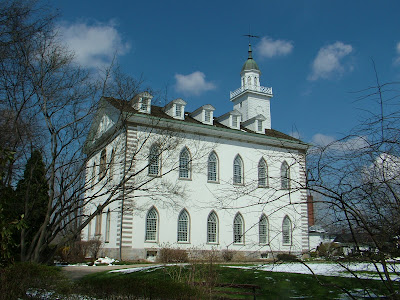Our introduction to Kirtland was one that I will remember. As we drove down and then up the hill the Temple grew directly in front as we got closer, until it filled our whole vision. It was lovely.
We decided to do the Temple tour first, since we were right there and it would cover the segment by the ‘Community of Christ’. After viewing a short film we were guided into the Temple. Unfortunately, we were not able to take pictures inside, so my memory will have to serve me. I will try to describe it as best I can.

We were taken to the top floor first, which was divided into four different rooms. The room on the far east side was the Prophet’s room and it was in here that he received D&C 137. In this vision he received an assurance that his brother Alvin would be blessed with an inheritance in the Lord’s kingdom, even though he had not received baptism. Again, there were enough windows in this room to make it pleasantly light, airy and even warm with sunshine.

An example of the different stages of construction for the seating pulpits in the Kirtland Temple. I included this so that you can see what they would have looked like. At completion they were painted white with gold edging. Each seat was marked with the priesthood office of the person sitting there.


This is the window that shines into the lower level of the Kirtland Temple. Just the other side of this window was where the Saviour, Moses, Elias and Elijah visited Joseph and Oliver.
The first and second floors of the Temple were very similar in design, with Aaronic Priesthood seating raised at one end and Melchizedek Priesthood seating raised at the other. The rest of the room contains general seating. From the ceiling, during Joseph’s time, there were pullies that could lower sheets to divide the room off into sections. This was to accommodate smaller groups for discussion and lessons. It was on the first level that the Father and the Son appeared to Joseph and Oliver, while the Temple Veil was lowered. They were also visited by Elias, Moses and Elijah.
The one practical observation I made was that each pew within the congregation was closed off with a door at the end in order to keep the warmth in. Very practical in a place where it would have been extremely cold in the winter, and at a time where heating was not readily available.

A view of Old Kirtland. Restored and reconstructed by the Church.
I loved Kirtland for its quaintness. It would have been lovely to see it in full bloom, and better still in the autumn. I can only imagine the colours it would produce. It had the feel of old England in places. We stayed overnight in Chardon, and the drive was magic. The snow was thick and fresh on the ground around us, and the houses took on a quaint appearance with their icicles hanging from the rooves.

We were able to attend the School of the Prophets which was located above the Whitney Store.

On the way out to the John Johnson Farm we stopped off to look at the quarrie where the saints dug the rock for the Kirtland Temple. It was covered in snow and was freezing, but well worth the stop. You can still see the chisel marks where they cut the rock. It is in the middle of a river and must have been cold and wet to work there. Joseph Smith was appointed the quarrie manager for a time.

The other highlight for us here was the John Johnson home. This was where the prophet and Sidney Rigdon were tarred and feathered and the school of the Prophets was held for some time. The greatest thing that happened here was when Joseph and Sidney had a vision of the saviour. As the vision progressed each would ask the other, “What do you see?” Almost with the idea of making sure they were both seeing the same thing.
One of the things that I hoped to do while in the east is visit a place were the Amish people lived. There are many places that they live throughout Ohio, Pennsylvania, Indianna and even Missouri and Iowa. On our drive out to the John Johnson Farm we drove through a place called Middlefield. They had a large cheese making factory there and a small Amish community. The Amish people do not like you to take photo's of themselves, but are happy for you to photograph their homes, buggies and farms. You can recognise an Amish farm by the grey and blue washing hanging on their lines (no one in the US hangs washing out, they wouldn't even know what a clothes line was. They dry their clothes in electric dryers) and by the lack of power lines, TV antenna's and cars around their houses.We stopped in at an Amish farm that had a little shop in the back and I bought a quilt sampler there. We chatted with the Amish lady there and her 9 year old daughter. They were dressed in their traditional clothes, with the starched white caps and simple grey dresses. It was a pleasant experience. I managed to catch a picture of two horse drawn Amish buggies passing each other on the main road into town. They are a simple people who don't rely on modern conveniences such as electricity, cars or telephones. It seems that both modern culture and Amish culture function well together in these areas.
 Two Amish buggies pass each other on the main road into Middlefield township, Ohio.
Two Amish buggies pass each other on the main road into Middlefield township, Ohio.






No comments:
Post a Comment